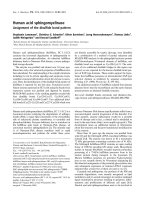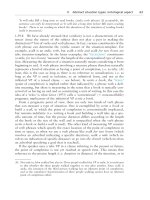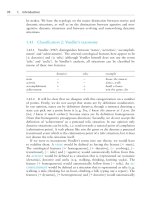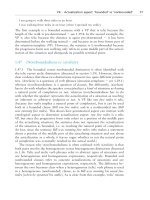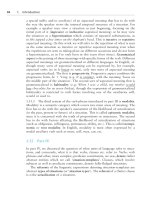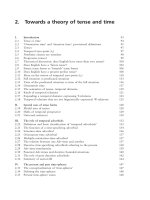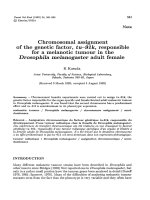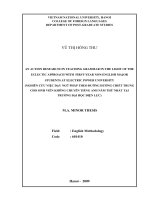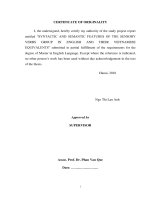assignment of english grammar issues of the english verbs
Bạn đang xem bản rút gọn của tài liệu. Xem và tải ngay bản đầy đủ của tài liệu tại đây (573.75 KB, 14 trang )
<span class="text_page_counter">Trang 1</span><div class="page_container" data-page="1">
<b>THĂNG LONG UNIVERSITYENGLISH DEPARTMENT</b>
<b>---o0o---ASSIGNMENT OF ENGLISH GRAMMARISSUES OF THE ENGLISH VERBS</b>
<b>Lecturer: Ngơ Hữu HồngStudent’s name: Nguyễn Anh TuấnStudent’s code number: A31725 List number: 4</b>
<b> HÀ NỘI, 2022</b>
</div><span class="text_page_counter">Trang 2</span><div class="page_container" data-page="2"><b>A. THEORY1. Meanings1.1. Verbs</b>
Verbs are words that denotes an action (sing, talk), an occurrence (appear, grow), or a state of being (be, exist, stand). Verb is the part of a phrase that describes the action the subject takes.There must be a verb in almost every sentence.
<b>1.2.Stative verb and dynamic verb</b>
English verbs can be segregated into two types: stative verbs and dynamic verbs. Stative verbs typically relate to a state or condition that is unchanging or is not likely to change, whereas dynamic verbs (also known as "action verbs") typically indicate actions that happen. The distinction between the two categories of verbs is significant as stative verbs typically cannot be used in the progressive form, while dynamic verbs can.
<b>1.2.1. Stative Verb</b>
Stative verbs don't describe an action, but rather a state of affairs. The progressive form is rarely applied to them.
<b>· I love her. (Example of my own)</b>
<b>· I don’t like eating breakfast.(Example of my own)</b>
Stative verbs often relate to:
· Thoughts and opinions: agree, believe, doubt, guess, imagine, know, mean, recognise, remember, suspect, think, understand
· Feelings and emotions: dislike, hate, like, love, prefer, want, wish · Senses and perceptions: appear, be, feel, hear, look, see, seem, smell, taste · Possession and measurement: belong, have, measure, own, possess, weigh.
<b>1.2.2. Dynamic Verb</b>
Dynamic verbs are those that describe the ongoing or progressive action of the subject. They convey the Subject's movement-related status.
<b>· The cat is chasing the rat in the corner of the house.(Example of my own)· Rain is falling hard outside.(Example of my own)</b>
</div><span class="text_page_counter">Trang 3</span><div class="page_container" data-page="3"><b>2. Forms</b>
<b>2.1. Forms of the Verb2.1.1. Verb Suffixes</b>
An addition of a letter or group of letters to the end of a word to create a new word is known as a suffix. Suffixes typically have a specific significance. A verb suffix is a suffix that is added to a root word to transform it into a verb.
Certain suffixes are used to create main verbs by adding nouns or adjectives. Here are a few frequently used noun suffixes and their definitions: (Link 2)
-ate To bring about a state Demonstrate, generate, communicate, illustrate
-en To become Shorten, thicken, widen, strengthen
-ify To make something, to become
Clarify, identify, modify, simplify
-ise To do something, to become Criticise, realise, modernise, optimise
<b>2.1.2. Regular Verbs and Irregular Verbs</b>
An English verb can be regular or irregular.
Regular verbs acquire their past tense and past participle by adding the suffix "-ed.". Regular main verbs have four forms that are constructed as follows:
· The base form: cook, start, open. · The -s form: cooks, starts, opens. · The -ing form: cooking, starting, opening. · The -ed form: cooked, started, opened.
</div><span class="text_page_counter">Trang 4</span><div class="page_container" data-page="4">Unlike regular verbs that use the ending "-ed" for both past tense and past participle forms, irregular verbs are a type of strong verb that doesn't follow the usual patterns for the past tense and the past participle. participle. Since irregular verbs have no set rules, it is crucial to remember their unique patterns, past simple and past participle forms. To illustrate, let's look at an example comparing the two types of regular verbs and irregular verbs below:
<b>Base form Past simple form Past participle form</b>
<b>2.1.3. Auxiliaries</b>
Auxiliary verbs have a purpose in conjunction with a main verb to convey the tense and mood of the main verb.
Auxiliaries are classified into two fundamental classes: the primary auxiliaries (be, have and do) and the modal auxiliaries (can, could, will, would, shall, should, may, might and must).
a. The primary auxiliaries:
"Be", "Have", and "Do" are the three basic auxiliaries used most frequently in English. All three can be used as major verbs and are involved in the development of numerous grammatical structures, but on their own, they don't mean much.
· Auxiliary verb "Be": (be, being, been, am, is, are, was, and were)
</div><span class="text_page_counter">Trang 5</span><div class="page_container" data-page="5">For passive sentences, the auxiliary verb "Be" is employed as follows:
<b>The car was damaged in an accident.(Example of my own)</b>
To express progressive aspect, the progressive auxiliary be is used:
<b>This summer is going to end soon.(Example of my own)</b>
· Auxiliary verb "Have":
The perfect auxiliary verb have is used to express perfect aspect:
<b>I have never had such a delicious meal.(Example of my own)</b>
· Auxiliary verb "Do":
In the absence of another auxiliary verb, the main auxiliary do is utilized as a dummy operator to construct negative or interrogative phrases:
<b>Do you love football?(My own example)</b>
<b>I did have to prepare for 2 exams yesterday.(My own example)</b>
b. Modal auxiliaries
The modal verbs are: can, could, will, would, shall, should, may, might, must. Regular verbs and modal verbs differ in a few key ways. First off, the Modals lack inflections (they have no -ing form, -ed form, and -s form for the third-person singular). Second, the Modal past tense form is frequently used to convey the present or the future. Finally, the infinitive verb form is usually used after a modal verb.
<b>· Can/Could watch the baby while I make a phone call?(Example of my own)</b>
· I must finish the homework in time.(Example of my own) The modals convey two primary meanings:
· Identifying whether an event has already happened, is currently happening, or will happen:
<b>Steven may be coming to visit us next week. (Perhaps Steven will come to visit us next week) (Example of my own)</b>
· The ability to control events:
</div><span class="text_page_counter">Trang 6</span><div class="page_container" data-page="6"><b>You must answer the question. (I demand you to answer the question)(Example of my</b>
<b>2.2. Forms of the Verb Phrase2.2.1. The Structure</b>
A standard structure of a verb phrase consists of a main verb followed by up to four auxiliary verbs. Each of the four belongs to a separate auxiliary subclass.
<i>mayhavebeenbeingblackmailed</i>
(Greenbaum, page72)
<b>2.2.2. The Main Verb</b>
There are four forms of verb phrase:
<b>· The base form: I go to school everyday.(Example of my own)· The -s form: My sister goes to school everyday.(Example of my own)· The -ing form: My sister is going to school.(Example of my own)</b>
<b>· The -ed form (past): My sister went to school yesterday.(Example of my own)· The -ed form (-ed participle): My sister had gone to school.(Example of my own)</b>
</div><span class="text_page_counter">Trang 7</span><div class="page_container" data-page="7">While most regular verbs have the same -ed form for past and -ed participle, some irregular main verbs have less or more forms than regular verbs.
Let's take the two verbs "be" and "cut" as an example:
The irregular verb "be" has the most forms, eight in all (Greenbaum, page 73): · The base form: be
· The -s form: am, is, are · The -ing form: being · The -ed form (past): was, were · The -ed form (-ed participle): been
The irregular verbs "fight" has only four different forms(Example of my own):
<b>· The base form: fight· The -s form: fights· The -ing form: fighting· The -ed form (past): fought· The -ed form (-ed participle): fought</b>
As we can see, the verb "cut" plays as the base form and also as the -ed form in the -ed past form and the -ed participle form.
<b>2.2.3. Tense, Person and Number</b>
Tense, Person, and Number of the first or only verb in the verb phrase are shown. The tense, a grammatical category that corresponds to the time of the event, is indicated by the verb's form. There are two tense forms: Present and Past, which can be further divide into twelve tenses.
· The present tense: I am doing my homwork.(Example of my own) · The past tense: I did not do my homework.(Example of my own)
</div><span class="text_page_counter">Trang 8</span><div class="page_container" data-page="8">There are three persons:
· The first person, who speaks or writes; · The second person, who is addressed; · The third person, signifies others; There are two numbers: singular and plural.
<b>2.2.4. Aspect</b>
The grammatical category of aspect describes how the speaker or writer perceives the passage of time in a situation; the aspect is denoted by a fusion of the auxiliary and verb form. The perfect aspect and the progressive aspect are the two aspects of verbs. The perfect progressive can be created by combining these two elements together. In addition to time, tense in a sentence also indicates a verb's aspect. The word “simple” in both present simple tense and past simple tense implies zero aspect.
<b>· Perfective aspect: I have played this new game for a month.(Example of my own)· Progressive aspect: The dog is running in the garden.(Example of my own)· Perfect-progressive aspects: The teacher has been teaching for 10 years.</b>
<i>(Example of my own)</i>
<b>· Zero aspect (simple aspect): I am a student. (Example of my own)2.2.5. Voice</b>
Verbs have two voices: active or passive.
<b>Active: I made a pie.(Example of my own)</b>
<b>Passive: The pie was made by me.(Example of my own)2.2.6. Mood</b>
Differences in verb tenses that express the speaker's viewpoint on what is being spoken are referred to as Mood. For finite verb forms, there are three moods:
· Indicative: The indicative mood is frequently used in exclamatory, interrogative, and declarative sentences.
<b>Ex: You can not see my answers!(Example of my own)</b>
</div><span class="text_page_counter">Trang 9</span><div class="page_container" data-page="9">· Imperative: The imperative is the fundamental form. It is mostly employed as a command to request action.
<b>Ex: Drop the weapon!(Example of my own)</b>
· Subjunctive: Mandatory subjunctive and "were" subjunctive are the two types of the subjunctive.
The mandative subjunctive has the base form. It is utilized in that-clauses after the concepts like demand or request
<b>Ex: They recommend that this law should be abolished.(Example of my own)</b>
· The "were" subjunctive gets its name from the fact that it always employs the verb "were". It is mostly used to convey a hypothetical or unreal situation.
<b>Ex: If I were you, I would never go to that restaurant.(Example of my own)2.2.7. Finite and Non-finite Verb Phrases</b>
a. Finite Verbs
Tense, verb, and main verb are characteristics of the finite. A finite verb phrase has a subject and verb that agree.
<b>· I plant a tree .(Example of my own)</b>
<b>· My cat eats the sausage. (Example of my own)</b>
b. Non-finite Verbs
One or more non-finite verbs that are the initial or sole verbs in the verb phrase are included in non-finite verb phrases. There are four non-finite verb forms:
<b>· The infinitive: I let the boy play in the yard.(Example of my own)· to – infinitive: We are ready to go now.(Example of my own)· The -ing participle: I love cooking(Example of my own)· The -ed participle: I have watched Titanic.(Example of my own)3. Functions</b>
<b>3.1. Compound and Complex Sentences</b>
</div><span class="text_page_counter">Trang 10</span><div class="page_container" data-page="10"><b>3.1.1. Compound Sentences</b>
A compound sentence is a sentence containing two or more independent clauses, linked by a coordinating conjunction (for, and, nor, but, or, yet, so).
<b>I’m a student and I go to school everyday.(Example of my own)</b>
It is also frequently to put clauses side by side and linked them by a semicolon instead of
<b>Everyone knows that I go to school everyday.(Example of my own)</b>
A subordinate clause, also known as a dependent clause, is a clause that does not express a whole idea, so it cannot stand alone as a complete sentence.
Adverbs, adjectives, and nouns can all be used in subordinate clauses.
<b>3.2. Irregular Sentences and Non-sentences3.2.1. Irregular Sentences</b>
Regular sentences are those that comply the main patterns, and those that do not comply the main patterns are determined as irregular sentences. The majority of irregular sentences are broken sentences. These omit words that we can easily substitute, usually from the context that came before.
<b>A: Where do you leave your wallet? - B: In my bedroom.(Example of my own)</b>
Judging from the context in the first sentence, it can be seen that A is asking B about the location of the key, and B's answer "On top of the refrigerator" makes sense even though it is not a complete sentence.
<b>3.2.2. Non-sentences</b>
Non-sentences are sentences that cannot be analyzed grammatically as sentences. They appear very commonly in newspaper headlines, book headings, titles, advertisements, notices and daily basic conversations:
· Man in black (Movie title)
</div><span class="text_page_counter">Trang 11</span><div class="page_container" data-page="11">· Hollywood Rebels (Magazine title) · Chill out (common dialogue sentence)
<b>B. PRACTICE</b>
<b>1.</b>
<b>Name the forms of underlined phrases in the following passage and their functions:</b>After a few days (1), he began to say good morning (2), and looking up (3) they found his face, a long head with a shining dark (4) dome surrounded with curly hair given a strong liveliness by the sharp coarse strokes of grey hairs, the beautiful curved nose handed out so impartially (5) to Indians, dark eyes slightly bloodshot from the sun (6), a wide muscular mouth smiling on strong uneven teeth that projected slightly (7) like the good useful teeth of an animal (8). But it was by his legs they would have known him; the dark, dull-skinned feet with the few black hairs on the big toe, the long hard shaft of the shin tightly covered with smooth shiny skin, the pull of the tendons at his ankle like the taut (9) ropes that control (10) the sail of a ship.
1. Prep Phrase Adverbial 2. Noun Phrase Object 3. Verb Phrase Adverbial 4. Adjective Phrase Noun Pre-modifier 5. Adverb Phrase Adverbial 6. Adjective Phrase Noun Post-modifier 7. Adverb Phrase Adverbial Complement
</div><span class="text_page_counter">Trang 12</span><div class="page_container" data-page="12">8. Noun Phrase Noun Post-Modifier 9. Adjective Phrase Noun Pre-modifier 10
Verb Pharse Non-finite Verb
<b>2. Analyze these sentences by identifying syntactic factors (Complex or Compound, types of Subordinate clauses and their functions): </b>
1. Watching TV, they heard a terrible explosion. This sentence is a complex sentence.
The subordinate clause is “Watching TV”. It has function of an adverbial of time. 2. What would happen to the young girl if she went out alone at midnight? This sentence is a complex sentence.
The subordinate clause is “if she went out alone at midnight”. It has function of an adverbial of time.
3. Mary likes wine but Tom likes soda. This sentence is a compound sentence.
Two independent sentence “Mary likes wine” and “Tom likes soda” are combined with conjunction “but”.
4. While in Paris, you should come to visit the Eiffel Tower. This sentence is a complex sentence.
The subordinate clause is “While in Paris”. It has function of an adverbial of time. 5. Since leaving school, he has traveled round the world.
This sentence is a complex sentence.
The subordinate clause is “Since leaving school”. It has function of an adverbial of reason.
6. You should learn as much as possible or you won’t find a job in the future. This sentence is a complex sentence.
The subordinate clause is “or you won’t find a job in the future”. It has function of an adverbial of reason.
7. What I had read in the book made me crazy about its main female character. This sentence is a compound-complex sentence.
The subordinate clause is “about its main female character”. It has function as an adverbial of reason.
</div>